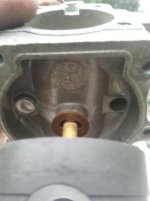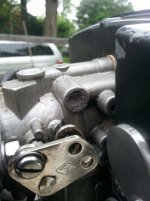Good Morning All.
Best wishes to the Moms out there.
Ok. 1988 Johnson 48 SPL ( with AB Jet) on a 1988 Lowe 160. Got it for a good price for my 15yo son who's turned into an avid fisherman. When purchased it would start only with throttle advance all the way. wouldn't idle. Rebuilt carbs (complete), checked spark, timing, compression. All good, except compression seemed low 95 top, 90 bottom) Got it adjusted so it would run and idle without the advance. The tach would bang up over 5500 RPMs on the hose. Yeah! not bad i figured. Put it in the river, and would shoot to 4000 rpm and bog its way down to 3400. If you backed off the throttle a tad, it would find a sweet spot at 3200 where it was moving well. Timing was spot on in the water also. I twisted the choke solenoid red lever to bypass and it jumped. ran great at 4400 rpms. So i figured it wasn't getting enough fuel. Easy, Rebuild fuel pump. Also got kit for choke solenoid. Put it back in yesterday, and same result. Worse actually. only hit 4000rpm.
Any gurus out there seen this. what am i missing.
BTW, New fuel tank pickup, hose, bulb, & connector. New CDI ignition.
Thanks in advance.
Ken
Best wishes to the Moms out there.
Ok. 1988 Johnson 48 SPL ( with AB Jet) on a 1988 Lowe 160. Got it for a good price for my 15yo son who's turned into an avid fisherman. When purchased it would start only with throttle advance all the way. wouldn't idle. Rebuilt carbs (complete), checked spark, timing, compression. All good, except compression seemed low 95 top, 90 bottom) Got it adjusted so it would run and idle without the advance. The tach would bang up over 5500 RPMs on the hose. Yeah! not bad i figured. Put it in the river, and would shoot to 4000 rpm and bog its way down to 3400. If you backed off the throttle a tad, it would find a sweet spot at 3200 where it was moving well. Timing was spot on in the water also. I twisted the choke solenoid red lever to bypass and it jumped. ran great at 4400 rpms. So i figured it wasn't getting enough fuel. Easy, Rebuild fuel pump. Also got kit for choke solenoid. Put it back in yesterday, and same result. Worse actually. only hit 4000rpm.
Any gurus out there seen this. what am i missing.
BTW, New fuel tank pickup, hose, bulb, & connector. New CDI ignition.
Thanks in advance.
Ken



